-
 Publications
Publications
-
 Research activities
Research activities
-
 Hybrid mobile hydraulics for excavators
Hybrid mobile hydraulics for excavators
-
 Lubricating Systems with Rotating Shafts
Lubricating Systems with Rotating Shafts
-
 0D models of axial piston pumps/motors
0D models of axial piston pumps/motors
-
 CFD studies on conical poppet valves
CFD studies on conical poppet valves
-
 CFD analysis of gerotor pumps
CFD analysis of gerotor pumps
-
 Lumped parameter models of crescent pumps
Lumped parameter models of crescent pumps
-
 Lumped parameter models of vane pumps
Lumped parameter models of vane pumps
-
 Lumped parameter models of gerotor pumps
Lumped parameter models of gerotor pumps
-
 Coupled simulation of telehandler hydraulics
Coupled simulation of telehandler hydraulics
-
 Modelling of brake booster vacuum pumps
Modelling of brake booster vacuum pumps
-
 Absorbed energy in ICE lubricating pumps
Absorbed energy in ICE lubricating pumps
-
 Multi-body simulation of axial piston pumps
Multi-body simulation of axial piston pumps
-
 Development of variable flow lubricating pumps
Development of variable flow lubricating pumps
-
 Optimization of ICE lubrication gerotor pumps
Optimization of ICE lubrication gerotor pumps
-
-
 Research projects
Research projects
CFD analysis of gerotor pumps (2014-2016)
Using Simerics MP+ (formerly PumpLinx), 3D dynamic models of gerotor pumps were developed. All models were experimentally validated on our test rig.
In particular, an in-depth analysis of the behavior under conditions of incomplete chamber filling was carried out. Figure 1 shows the complete pump model developed in Simerics MP+. To verify the software’s ability to account for variations in pipe geometry, two restrictors (R1 and R2) were inserted. The three configurations analyzed are: (1) without restrictors, (2) with restrictor R1 only, and (3) with both restrictors.
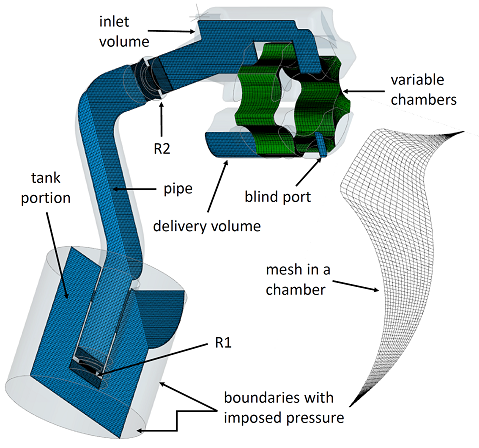 Figure 1
Figure 1
Figure 2 shows the model validation as a function of speed. Tests were performed on the lubricating pumps test rig. Two typical regions can be observed: at low speed, a linear behavior indicating complete filling; at high speed, the flow rate tends to saturate, indicating incomplete filling.
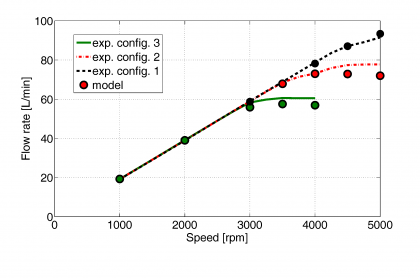 Figure 2
Figure 2
The pump was also tested in a closed circuit, with the possibility of increasing and decreasing the inlet pressure. Figure 3 shows the flow rate at three different speeds as a function of the suction pressure measured inside the inlet volume. It is interesting to note that at 2500 rpm the pressure can be reduced to about 0.25 bar absolute without any reduction in flow rate.
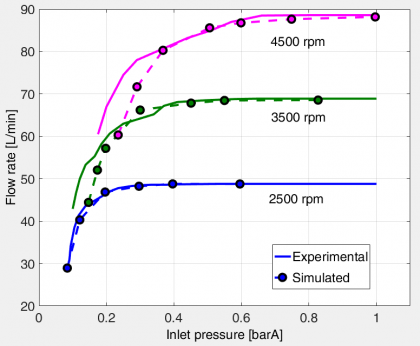 Figure 3
Figure 3
The influence of some geometric parameters on pump filling has been analyzed. For instance, by changing the eccentricity e of the reference gears, it is possible to modify their axial height H while maintaining the same pump displacement. The new profiles are shown in Figure 4.
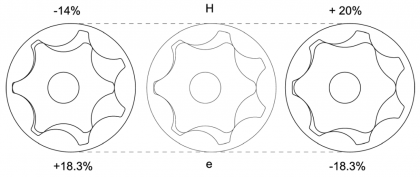 Figure 4
Figure 4
Under defective filling conditions (high speed), reducing the axial thickness significantly increases the volumetric efficiency (Figure 5).
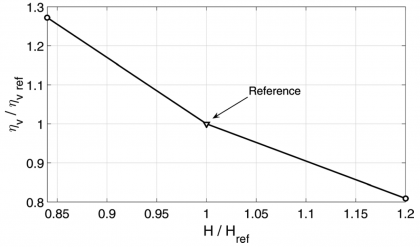 Figure 5
Figure 5
More analyses and details are available in:
ALTARE G, RUNDO M, 2017: Advances in simulation of gerotor pumps: An integrated approach
